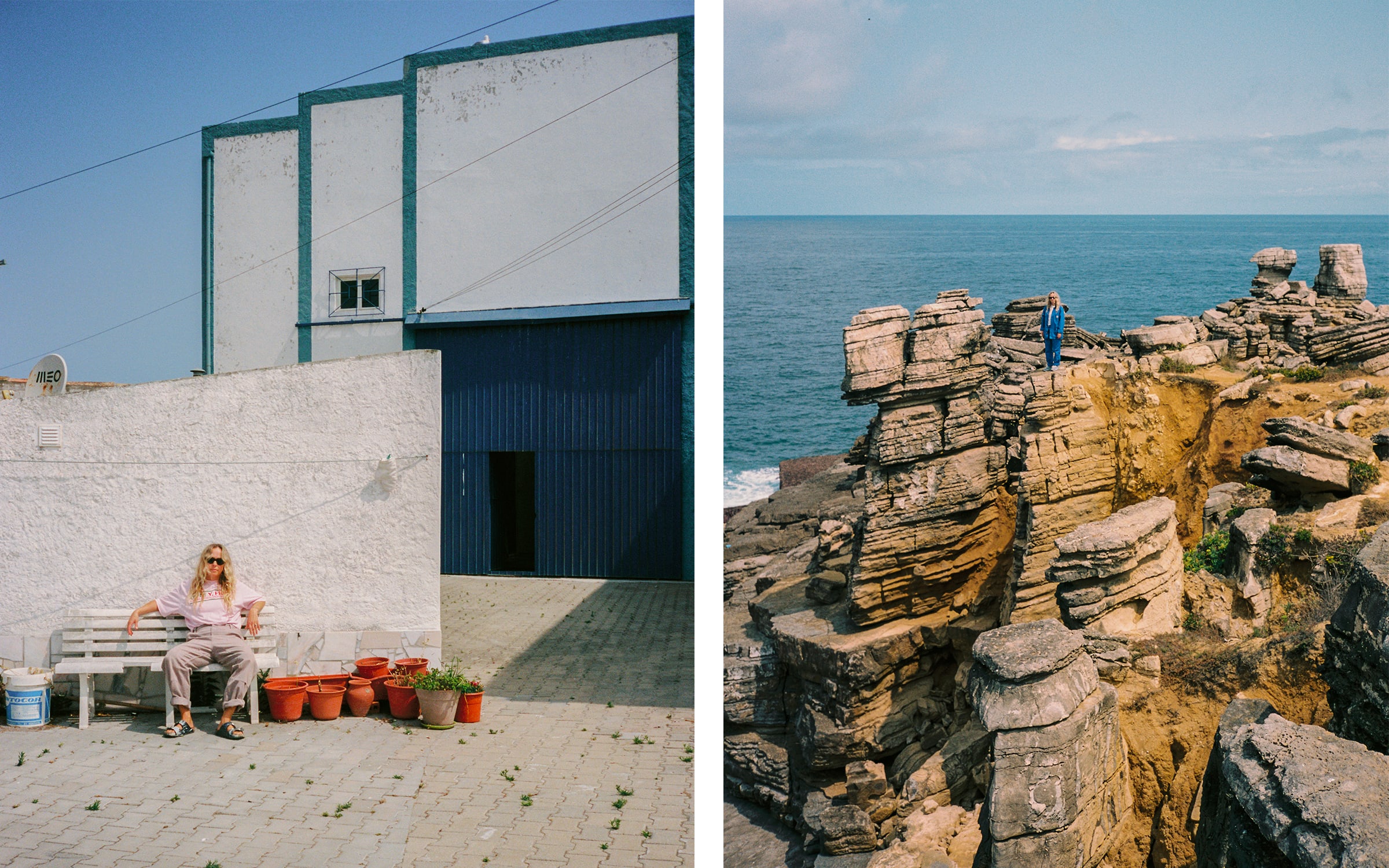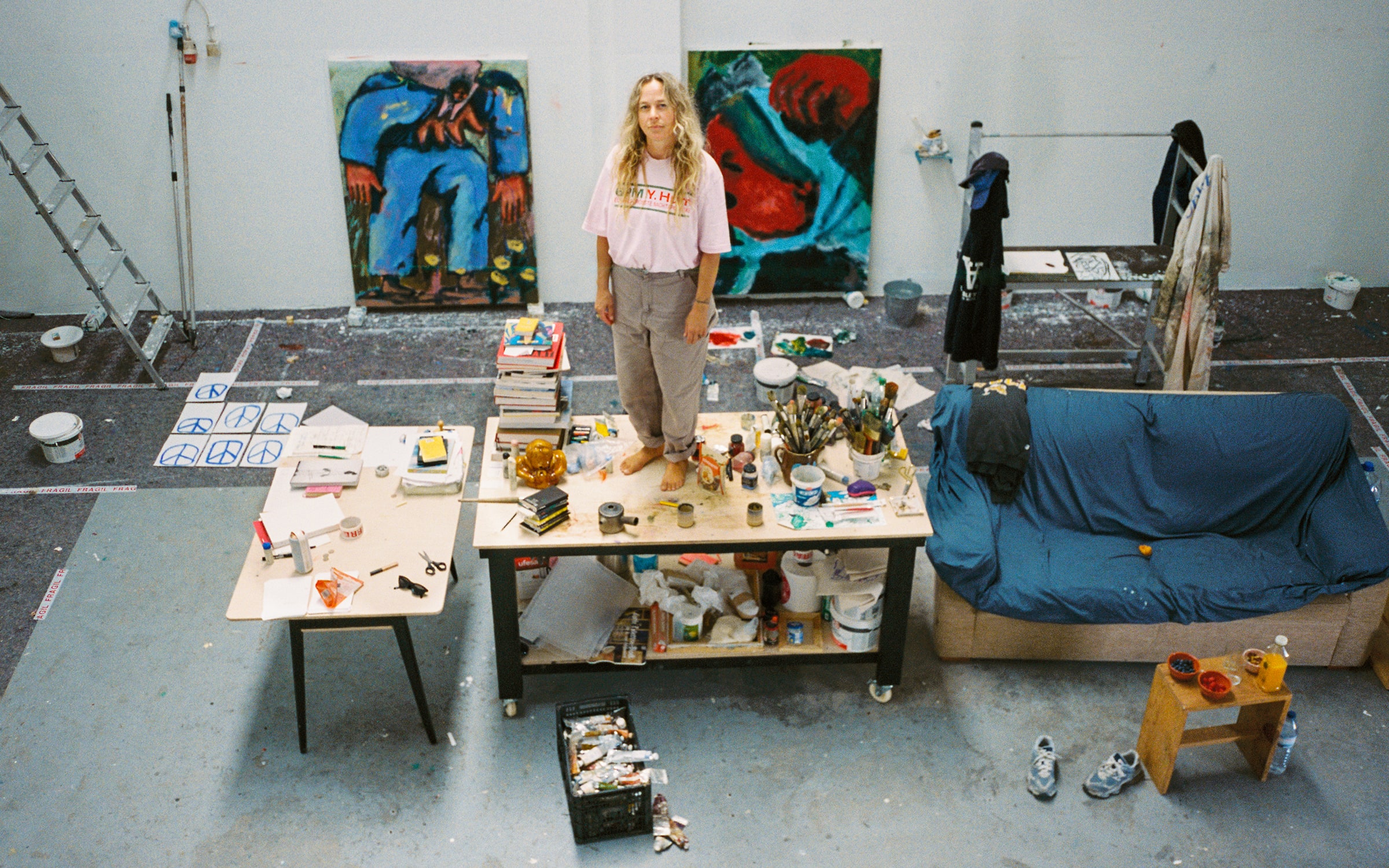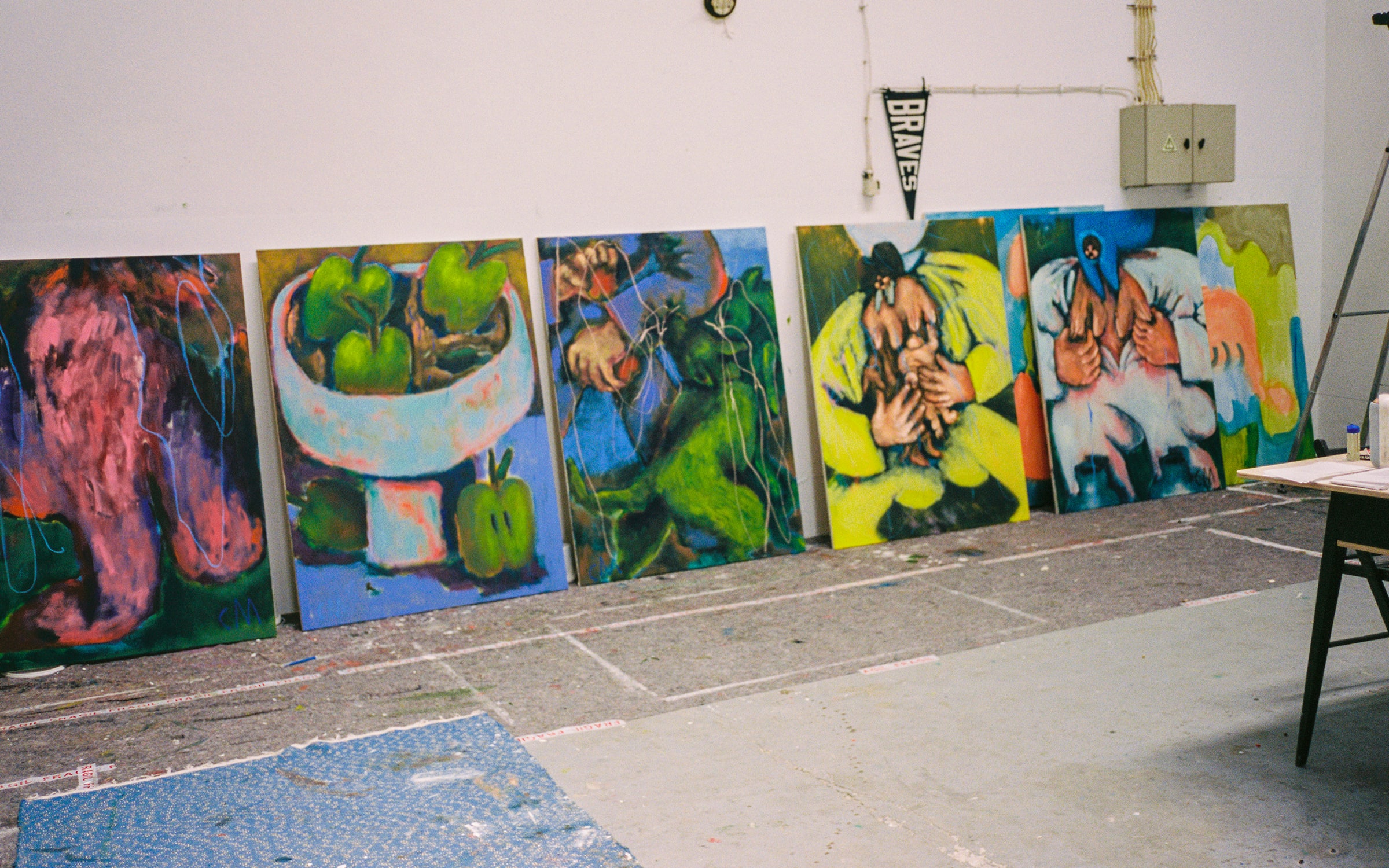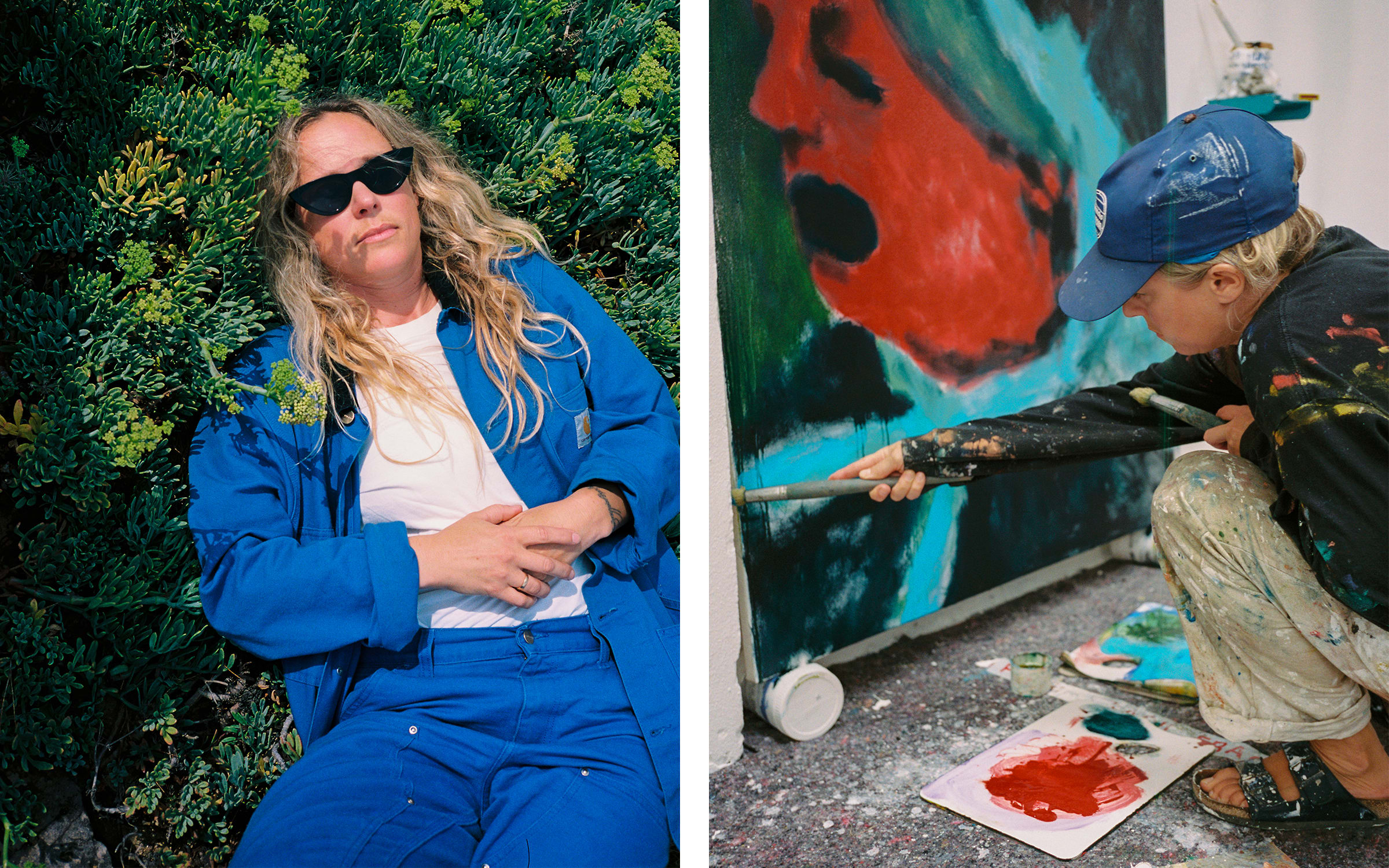There has been a steady flow of Central Europeans settling in Portugal in the last few years, chasing sunshine, five-euro meals, and a slower pace for their work-from-home routines. They choose the capital, Lisbon, or the warmth of the Algarve. I am going in the opposite direction, a hundred kilometers north of Lisbon, to pay a visit to the German artist Conny Maier, who has a studio in the fishing and surfing town of Peniche. It is an unexpected destination for a visit to an expat: Peniche is a small, rocky peninsula within a peninsula, known mainly by locals.

In fact, it was Maier’s determination, rather than a migratory trend, that led her to Portugal. She was born in Berlin and it was there that she once saw a woman riding a wave on the cover of a surfing magazine and thought, ‘I want that.’ She found her way to Baleal Beach in Peniche a few years later. After traveling here each summer for a few years, she decided to call it home and commute whenever necessary to Berlin. To ensure I find my way to her remote studio, Maier sent me a photo of the building. Its modernist shape is framed by a blue strip, typical of Lusitanian houses. The deep-blue metal door and whitewashed walls of the entrance prompted a flashback to my Portuguese childhood summers in seaside towns with their dusty back roads.

Maier’s paintings do not replicate real places; rather, they create brawny beings, from fruits to humans. Nearing Peniche, I spot a stone pine engaged in a daring balancing act on the side of a hill. The tree’s tortuous trunk and mushroom-shaped dark-green top, emerging from the deep brown of the soil, under the bulbous, stormy clouds, awaken memories of Maier’s work. It evokes her color palette and unique textured brushstrokes: swift and intentional but also uncannily transient, filled with vibrant energy. The creatures she paints are neither human nor mythological, but a bit of both. Like the stone pine, they are elongated in places where logic tells us they shouldn’t be. Extended backsides, oval mouths, tubular feet, and wide torsos all bear a familiar timeless truth.
Inside the studio, the tall walls are filled with medium and large paintings stapled to the walls and on stretched canvases. Some depict four-breasted humanoid bodies and a few are still lives – all have been produced for her upcoming solo exhibition at the Langen Foundation in Neuss, Germany. In one, a bulging figure dressed in purple, grabbing a round object in each hand, has its back turned to me; the swath of purple is crossed by bright-red lines, granting it volume. The edges of the canvas seem to momentarily enclose the creatures who, nevertheless, appear as though they could have enough hubris to leap out of the painting. ‘That one is called O Gigante,’ she tells me, ‘The Giant’ in English.
We fall into deep conversation about Maier’s passion for history, in particular the former German Democratic Republic and Eastern Europe. Her grandparents spoke Polish, Russian, and German and lived a life of labor on farms until they settled into white-collar jobs. The creatures she paints with scarves around their heads may be a reflection of the fragmented family stories she’s pieced together over time. Maier is confounded by the contrast between the histories of poverty in Eastern Europe during the last century and the sustainable lifestyles that still thrived despite these hardships. She conveys this critical relationship to history and the Holocene through layers of interpretation: exaggerated colors, ambiguous scenes, arcane shapes, the familiar trope of the body, the forlorn archetype of the peasant, non-human stuff. The ambivalence expressed in Maier’s paintings, stemming from their open narratives, make their way into your psyche. Their softness, like the stone pine’s deceivingly fluffy appearance, is haunted by a threatening spikiness. ‘Yes,’ says Maier grinning, ‘people say “nice colors but…odd shape.”’

I ask if she paints, or at least starts, her large-scale works on the floor. But no: Maier not only staples the raw canvas to the wall, but also uses a stick at least a meter-long to paint. The stick, to which she has attached her brush, rests next to an unfinished painting. ‘It’s better for proportion, even when it goes wrong. I lose control. When I am too precise, I can’t get rid of myself.’ She adds, ‘I also have my oil sticks over there. This is the first time that I made them. For the Basel painting, the oil sticks were too thin, and I didn’t have the right colors, so I made them myself. It was really fulfilling to make my own tools and then have a color that no one else has.’ Here, Maier is referring to The Source (2023), a six-by-nine-meter diptych presented in Unlimited at Art Basel this year. In it, the lines she often draws on the finished paintings alternately squirt from the figures’ eyes or rain down on them, creating a dynamic of sorrow.
I wonder if her use of irregular lines build a distance between the texture, the scene, and the viewer. ‘The distance should destroy the painting; it should take you away from the too-lovely surface. And I can’t go back. It is not removable.’ When Maier tells me that everything comes at the same time – color, composition, and figuration – I wonder if it displeases her that I think of the era of Fauvism. ‘No,’ she exclaims, ‘when I saw Ernst Ludwig Kirchner’s exhibition at Hamburger Bahnhof in Berlin, I was really like…it doesn’t get any better than this.’

In the picture of the studio Maier sent me, there is a minuscule house in the foreground, almost covered by a colorful string of clothes drying in the white sun. As I leave, I see a woman laboring away in the dark, reminiscent of times gone by, of Maier’s figures with their oversized headscarves. But I may be imagining this; I may be adding yet another layer to Maier’s polysemic paintings.
Conny Maier is represented by Société (Berlin) and Ruttkowski;68 (Cologne, Paris, Düsseldorf, New York). Conny Maier’s first comprehensive institutional exhibition, ‘Beautiful Disasters’, curated by Udo Kittelmann, will be on view at the Langen Foundation in Neuss, Germany from September 3, 2023 to April 7, 2024.
Joana P.R. Neves is a Portuguese, London-based independent writer and curator. She is currently writing a book titled Female Drawing Machines, which will be published by Bloomsbury.
Published on August 15, 2023.
All photos and videos by Carolina Pimenta for Art Basel.